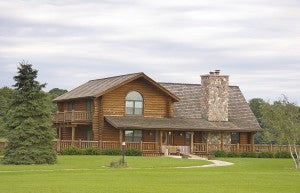How to Apply Log Home Stain In 5 Steps

Applying stain to your log home is crucial, of course! The structural integrity of your home is the focus; and staining and other finishing products will provide a highly-effective shield against the bombardment of natural elements as well as insect infiltration. Logs, being a natural building material, will be subject to decomposition and require preservation and preventative maintenance; and this is where staining and sealing of the logs make their entrance. And depending on the quality of the stain product you choose, exterior stains can perform beautifully for up to five years or more. A good way to check to see if it is a staining year for your home, simply compare your most weathered outside wall to the least-exposed. If you easily see a color difference, then it’s time to re-stain.
Are you contemplating staining your log home on your own? As with any home maintenance project, taking the appropriate steps with the right equipment and materials will ensure a frustration-free endeavor and a beautiful, well-protected residence. If you are a determined do-it-yourselfer then keep reading.
5 Steps For Log Home Stain Application
Step 1: Washing
Use a pressure washer on the lower setting to make sure the existing finish remains in-tact. The pressure washer should be set at around 1500 pounds per square inch. Higher pressures will actually damage the wood. Pay more attention to the upper areas of the logs since more contaminants can collect there. Before you begin any washing, take note of any suspected areas of rot or excessive moisture retention. It will take several days for your logs to air dry; but once the logs are dried, you’ll need to test the adhesion ability of your old finish. Simply apply a strip of masking tape onto a log’s surface. If the tape can be removed without peeling away any finish, then the old finish can remain. If the removed tape has finish particles that have adhered, then the old product will need to be stripped before any stain is applied.
If your log home is new, the logs should be treated with a specialized log-wash solution to remove mill glaze, road grime, mud and dirt that accumulated during the building phase. If foreign substances are not adequately removed, adhesion of the stain will be compromised. Other options for cleaning the logs include sanding, power-washing or corn blasting. When cleaning solutions are used, always apply cleaners from the bottom of the walls going upward and do just the opposite for the rinsing—from the top down. And always avoid products that contain a high level of pH such as chlorine bleach and TSP. Also, shy away from using oxalic acid unless you need to eliminate iron tannate or rust stains.
Step 2: Stripping
Assuming your old finish will need to be removed, find a good-quality chemical stripper. Following manufacturer’s directions, test a small area, first, to see how effectively the stripper will work. Don’t skimp on cheaper products—you’ll just end up with more work and a good dose of disappointment and aggravation.
Step 3: Inspect Chinking
Now’s a good time to scrutinize your home’s chinking or caulking. If you notice any cracking or receding, remove ineffective materials and replace with new. Chinking can be applied with a putty knife of caulking gun; and there are dozens of various caulking and chinking products available.
Step 4: Apply Stain
Prior to staining, cover walls and doors, shrubbery, decks etc. with plastic sheeting. Assuming the logs are completely dry, apply the stain according to manufacturer’s directions; and usually, the stain product can be applied with a brush or airless sprayer. Make sure to test a small area or piece of sample wood with the finish you desire in order to get an idea of how light or dark the stain will be. If you would like to minimize any darkening effect, here’s a neat little trick: First, apply a clear primer that will enable you to put a color coat on as a second coat. You must make sure, however, that the primer coat is free of oils or waxes! Multiple coats of stain can be applied, and with many products, a two-coat minimum will be required. Some stains have a built-in sealer and regardless of the type of stain you use, it’s important to wear eye protection as well as a dust mask for obvious reasons.
Step 5: Apply Top Coat
Protecting the stain with a clear topcoat will reflect ultraviolet rays and add an additional layer of water repellency. But keep this in mind: Never use varnish, shellac or a polyurethane, non-breathable coating of any kind! Strange as it may seem, logs need to ‘breathe’.
After it’s all said and done, you log home will look new, once again!
